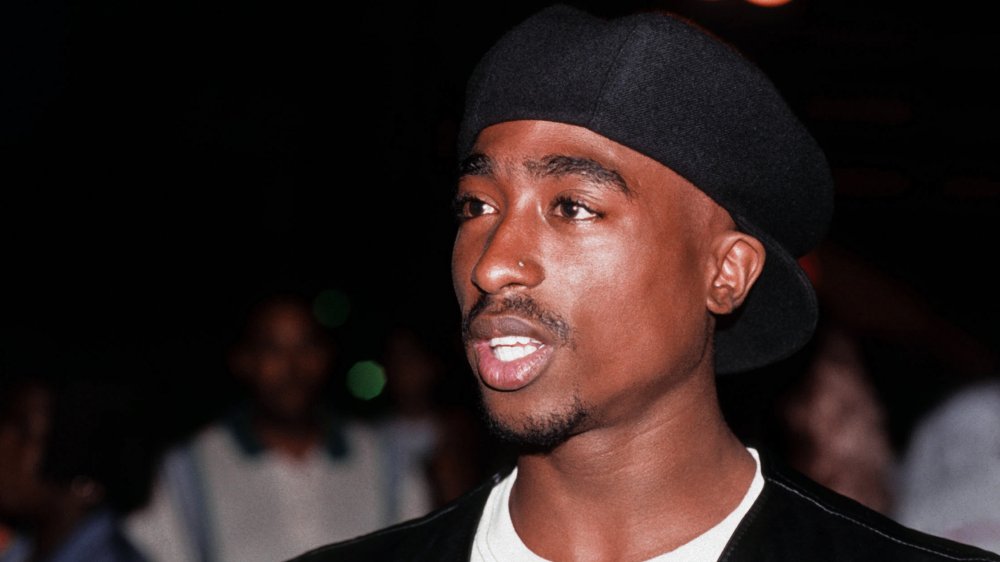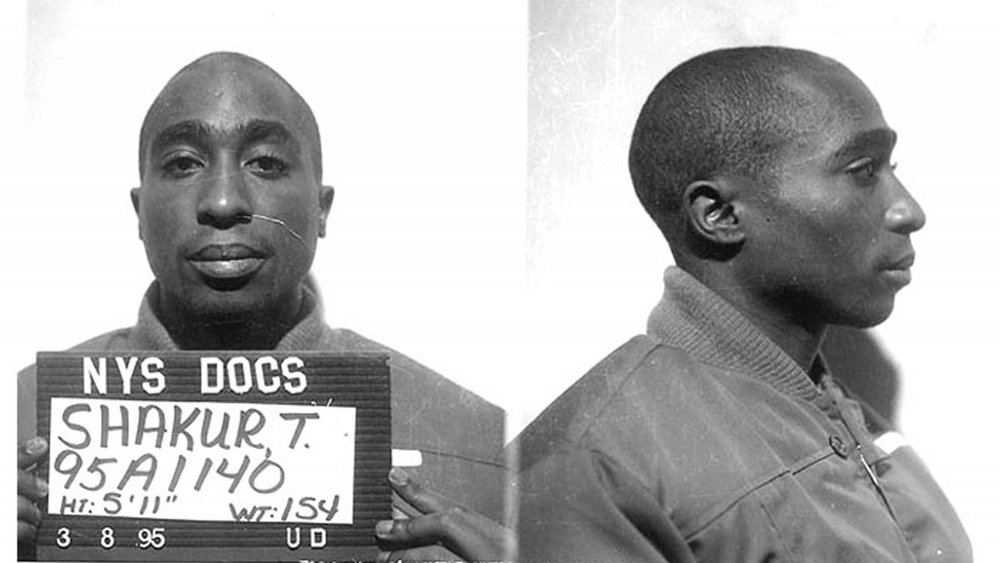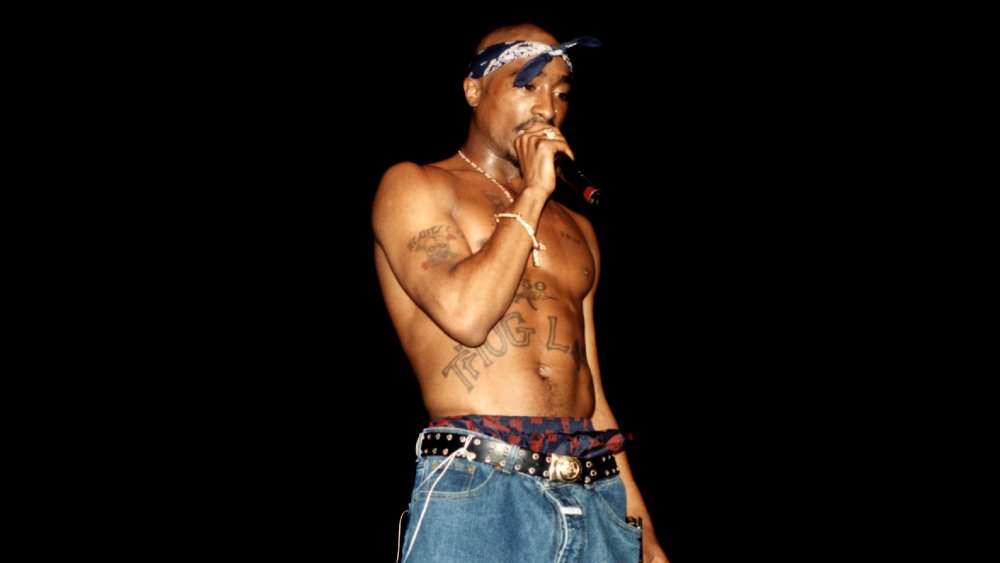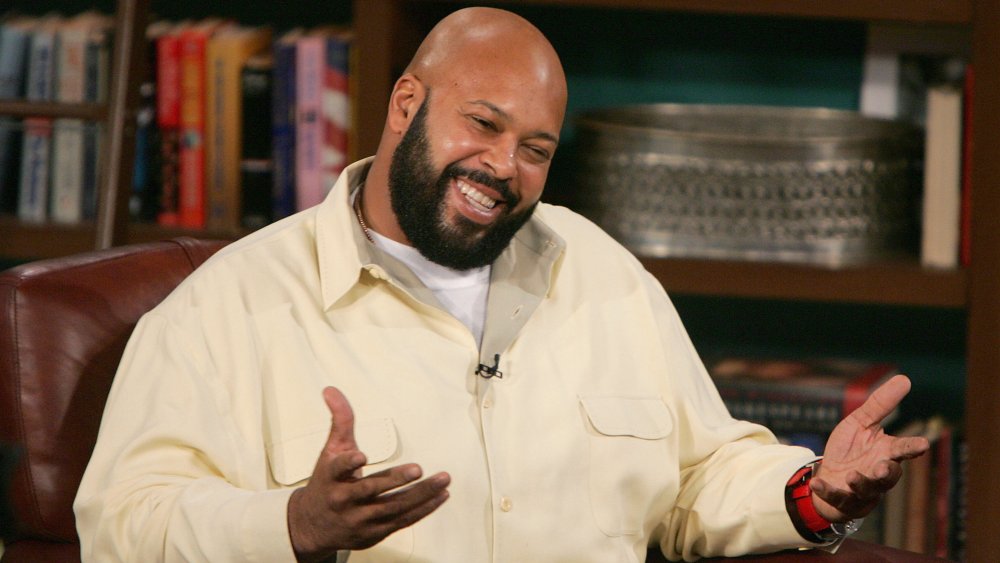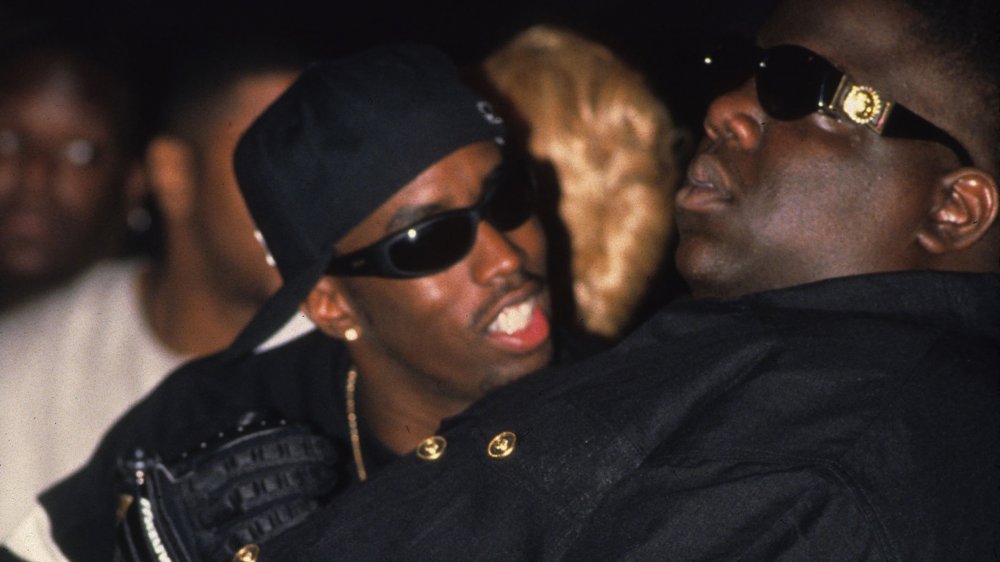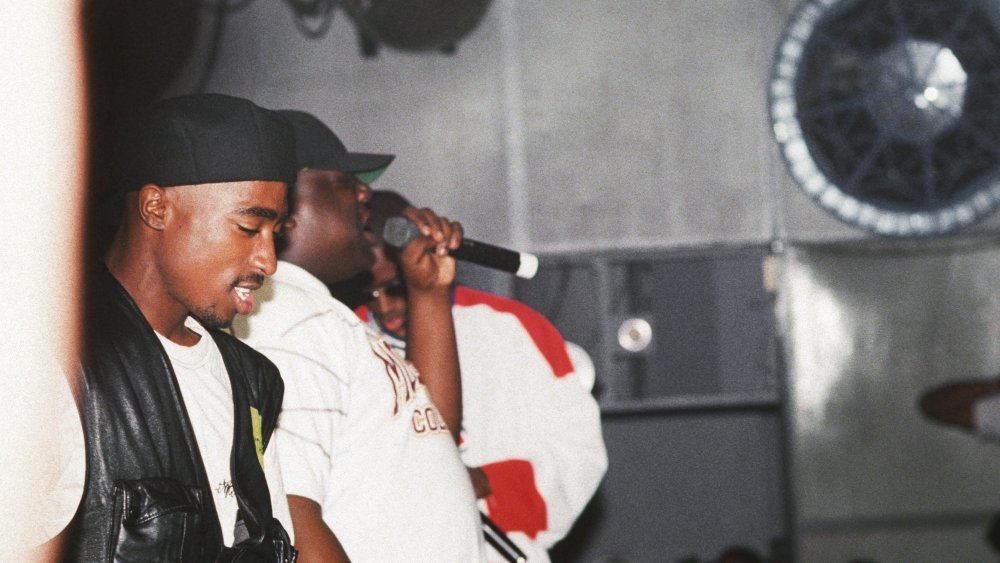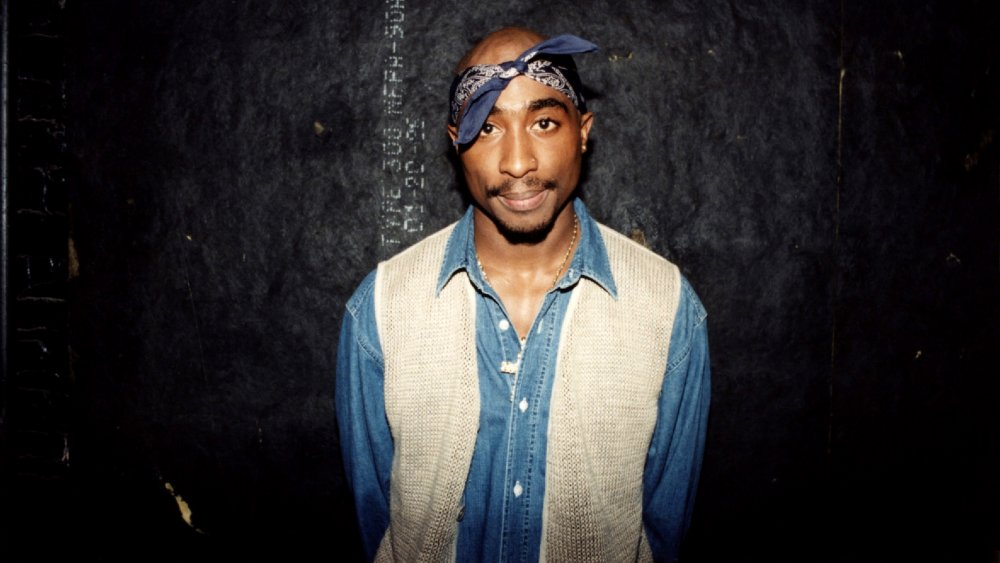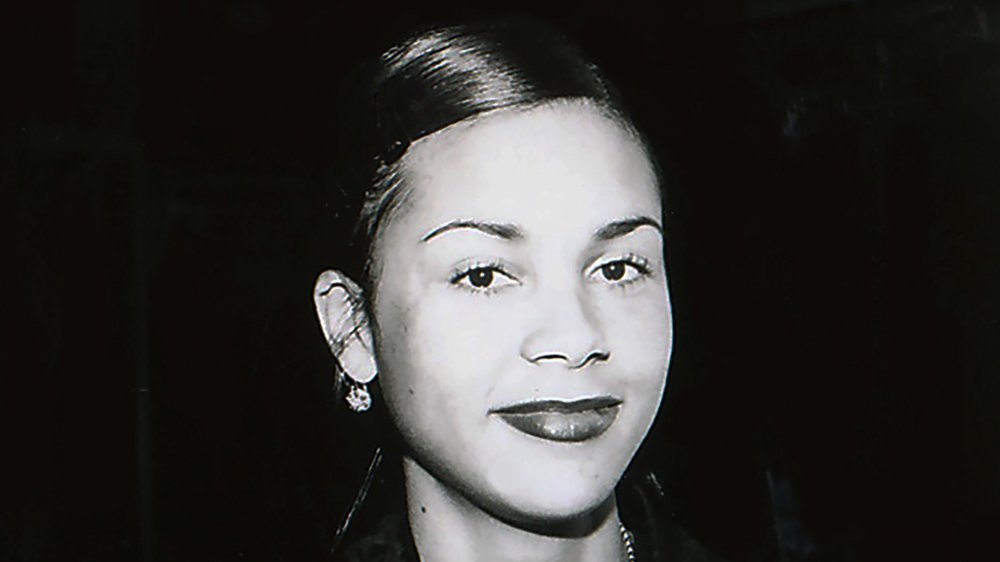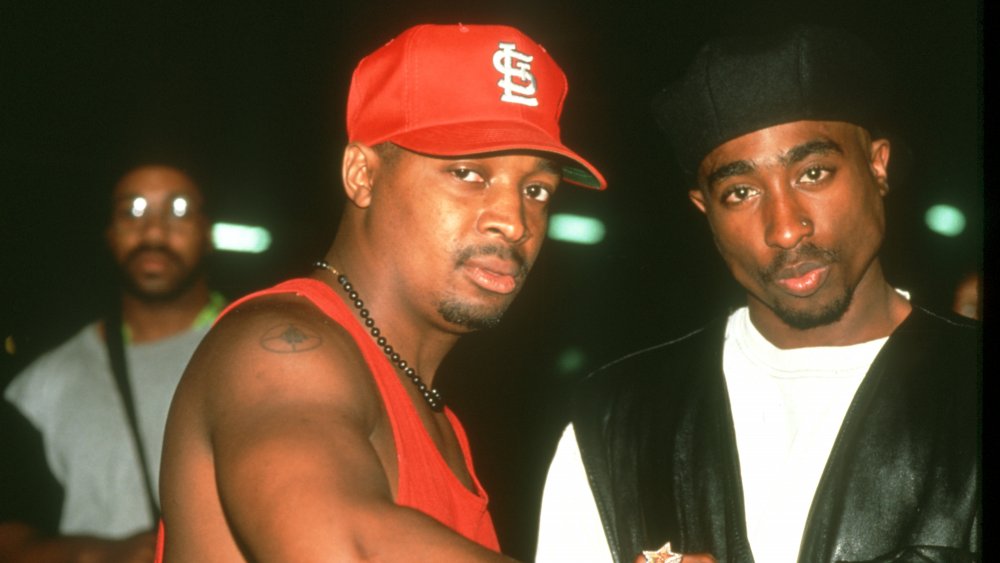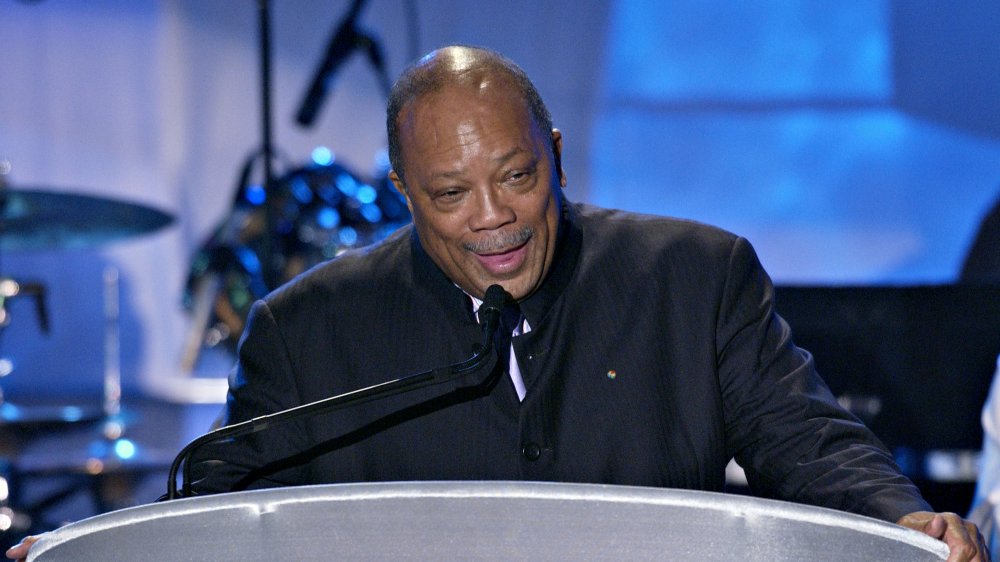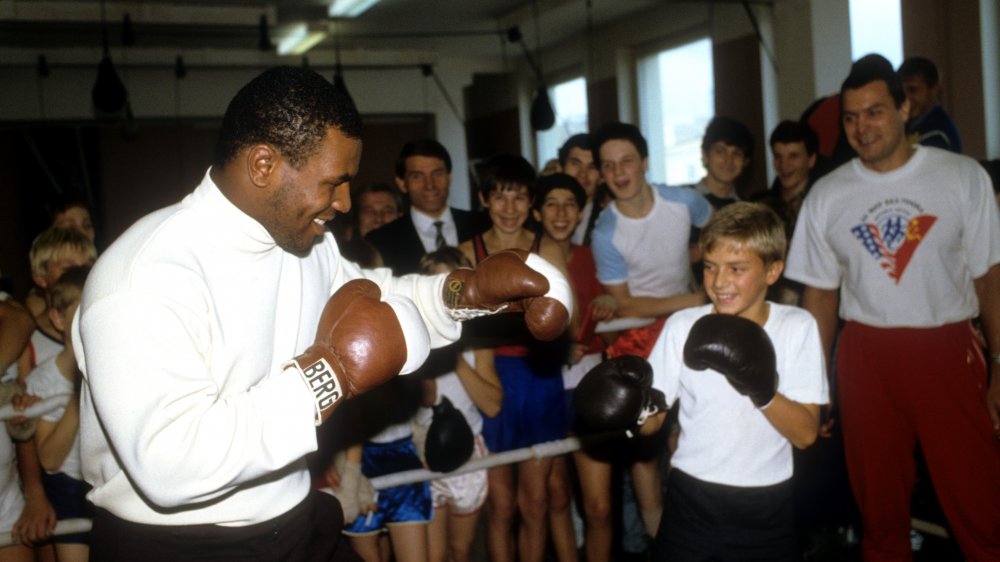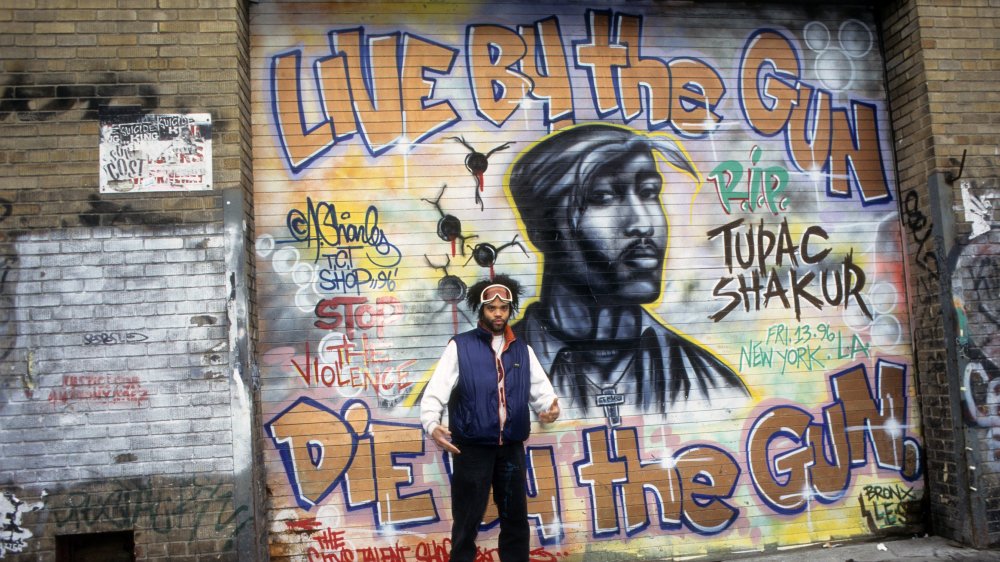What The Last 12 Months Of Tupac's Life Were Like
Despite being murdered at 25 years old, Tupac Shakur left one of the most important musical legacies of his era, especially in the musical genre he helped redefine. With his emcee name, 2Pac, just being a different spelling of his regular name, Shakur exploded onto the hip-hop scene in late 1991 with his debut album 2Paclypse Now, which combined the socially conscious rap of emcees such as Public Enemy and Queen Latifah and the gangsta rap of artists like N.W.A. and Ice T. Vibe described the album as "a middle ground for fans" of the two subgenres.
On Rolling Stone's 100 Greatest Artists, Shakur was ranked No. 86. Rapper 50 Cent said of Shakur, "Tupac was like a camera. It's incredible how much he wrote — how much he documented. To me, 'Pac was more of a poet than a rapper." He also states, "My favorite Tupac album is The Don Killuminati. It was recorded after he was shot and spent time in prison. It was like a doctor told him he was going to die, and he was trying to get it all down on paper."
Tupac Shakur's final 12 months were just that. With an ongoing feud between the two coasts of the United States and a personal feud with a former friend, Shakur's last year was spent attempting to take control of his turbulent life, before meeting a violent end in September 1996.
Tupac spent most of 1995 in prison
The first couple of months of the final year of Tupac Amaru Shakur's life were spent in Clinton Correctional Facility in New York. In November 1993, Shakur and three other men were charged with sexually assaulting a fan named Ayanna Jackson in the artist's New York hotel room. Rap music and its subgenre, "gangsta rap," drew controversy during this period for a string of arrests of other hip-hop stars, as well as protest from Black leaders for what they perceived as misogynistic lyrics. In February 1995, the rapper/actor was found guilty of first-degree sexual assault and sentenced to 18 months to four and a half years in prison. To VladTV in 2018, Ayanna Jackson spoke about her relationship with the rapper and the night in question for the first time. Jackson's name had been kept anonymous throughout the trial.
Up until his death, Shakur denied all the charges and accusations against him. According to LADbible, Shakur apologized to Jackson at the trial but also said to the judge, "I'm not apologizing for a crime. I hope in time you'll come forth and tell the truth." Judge Daniel P. Fitzgerald did not believe Shakur and told him that his crime was "an act of brutal violence against a helpless woman."
Shakur's time in prison lasted from February to October 1995 before he was released on a $1.4 million bail posted by Death Row Records' CEO Suge Knight.
Tupac married and divorced his girlfriend
Despite being convicted of sexual assault on a female fan and being in prison for a lot of 1995, Tupac's relationship with his girlfriend Keisha Morris continued. According to 2Pac Legacy, the pair met in June 1994 at a Chippendale's Club, and the night ended with the pair dancing and exchanging numbers.
You'd expect that the pair's relationship would hit a snag when Shakur was sent to prison, but during that time, Shakur became more reliant on Morris. He asked her to take care of all his finances, as Morris recalls: "Once Tupac was placed in the Clinton Correctional Facility Tupac asked me to handle all of his business with his lawyers, managers, and record company because he wanted me to represent him, he felt it would be better and easier if I were married to him. I was kinda hesitant but I agreed."
On April 29, 1995, in front of 2Pac's mother and his cousin, the pair got married. However, the whirlwind romance did not last long. In late July of the same year, Shakur and Morris unofficially divorced. They officially split a week after he was released from prison that October. In a 1997 interview, Morris noted that "things were getting very different once he got bail, and I felt like I wasn't needed anymore." Despite these harsh words toward her ex-husband, the two remained friends until Shakur's murder, according to Pop Sugar.
Suge Knight signed Tupac to Death Row
According to Vice, while incarcerated in prison, Tupac asked Morris to call the CEO of Death Row Records, Suge Knight, and relay a message: He needed help. Because of the financial strain of lawyers and being unable to tour, make new music, or act, not only was Shakur going broke, but his mother, Afeni Shakur, was close to losing her house. Reggie Wright Jr., the head of security at Death Row, said that Knight sent the jailed rapper $15,000 to alleviate Shakur's financial struggles. After that act of generosity, Shakur and Knight set up a meeting in prison, at which Knight and Death Row's lawyer, David Kenner, said they would help him get released on an appeal bond.
Knight would have seemed like an angel from Heaven for Shakur. Kevin Powell writes about a conversation he had with Shakur in December 1995 in his memoir, The Education of Kevin Powell. Shakur told him that "he could trust Suge Knight and the Death Row family to protect him from his enemies." Powell also said that Shakur talked about being angry with a number of people.
From a business perspective, it made sense for Suge Knight to try to entice one of the best rappers around to his label. According to Boom Box, Shakur signed with Death Row on September 16, 1995. A month later, he would be released on a $1.4 million bail following an appeal of his conviction.
The East Coast/West Coast rivalry explodes
The rivalry between Los Angeles-based Death Row Records and the New York-based label, Bad Boy Records, was the height of the rivalry between the East and West Coasts in hip-hop. Hip-hop music was born and developed in New York City, and when the genre exploded in popularity and began to spread around the country, the East Coast remained its base. According to Throwback History, West Coast performers felt that their music was ignored and downplayed on New York radio, and East Coast performers felt the same way on the West Coast.
Suge Knight both unintentionally and intentionally threw gasoline on this fire. First, with the unprecedented success of his Death Row Records, the center of hip-hop shifted from New York to California. According to The Independent, the company's first two albums, Dr. Dre's The Chronic and Snoop Doggy Dogg's Doggystyle, sold more than 13 million copies. As they put it, "Death Row Records not only sold a sound; it sold a lifestyle."
Knight intentionally stroked the flames at the 1995 Source Awards that August, when he took some not-so-subtle shots at Bad Boy Records' CEO Sean "Puffy" Combs. Medium titled the evening in a 2015 article as "The Day Hip-Hop Died." When Shakur stepped out of jail to join Death Row Records, he became a target in a Montague-vs.-Capulet blood feud.
Tupac vs. The Notorious B.I.G. and others
The final 12 months of Tupac's life were marked with several feuds, with his beef with The Notorious B.I.G., born Christopher Wallace, the most well-known. His disputes extended to several rappers from the East Coast, as well as an influential politician and a former Death Row colleague.
According to Biography, Tupac's feud with his former friend, Wallace, began when he was shot at Quad Studios in November 1994. He believed that Wallace and Sean Combs, who were in the studio at the time, were responsible for the shooting. Both Combs and Wallace denied the accusations, but that didn't stop Shakur from claiming to sleep with Wallace's wife, singer Faith Evans (which she denied), and releasing the diss track "Hit 'Em Up," which called out Wallace and Combs.
Other New York emcees that Tupac had beefs with, according to 2Pac Legacy, included Mobb Deep, Nas, the Fugees, and Jay-Z. Even Dr. Dre, who produced Tupac's hit song, "California Love," two months after he left prison and helped establish Death Row with Suge Knight, was in Shakur's scope after leaving the label in March 1996.
His 1996 songs "How Do You Want?" and "Wonda Why They Call u B*tch" attacked Congresswoman C. Dolores Tucker, who had launched a campaign against gangsta rap and the labels producing the music. According to Black Past, this led to a $10 million lawsuit against Shakur's estate.
Tupac recorded and released All Eyez on Me
Almost immediately upon being bailed out of prison by Suge Knight and signing a three-album deal with Death Row Records, Tupac recorded his first album at his new Death Row home. All Eyez on Me became Shakur's fourth studio album and the last he would release during his life.
In an interview with LA Times journalist Chuck Phillips (via HipHopDX), Shakur described his focus and commitment with his first album since leaving prison: "I have been in the studio since the day after I got out. [...] About twelve hours a day. Up until they kick me out. It be dark and everybody gotta go to sleep, people be passing out, so I'm like, 'Okay, I guess we gotta go home now.' So then we go home, come back early in the morning, and do it again."
Shakur described the album as "a reaction to the backlash from C. Dolores Tucker, Bob Dole, all those people that kept sweating me about the music." In just two weeks, according to Revolt TV, Shakur recorded 27 tracks for the double album, which would eventually hit diamond status. Upon finishing the album, Shakur still was very much focused on making music, — producer Johnny J said that the rapper had started working on something similar to his third album, Me Against the World, before focusing on another project.
Tupac moved in with Kidada Jones
The fact that Kidada Jones and Tupac Shakur became a couple is close to a miracle. In a 1993 interview with The Source Magazine, he was quoted as saying of legendary producer and musician, and Kidada's father, Quincy Jones, "All he [Quincy] does is stick his d*ck in white b*tches and make f*cked up kids." According to Cheat Sheet, Tupac approached Kidada at a nightclub months later to apologize, believing her to be Rashida Jones, Kidada's sister who responded to Shakur's comments in Source. In a VH1 interview, Kidada remembers listening to Shakur apologizing and thinking that "he is so cute."
The two began a relationship, which Quincy Jones at first disapproved of strongly, even telling Kidada that she could not see Tupac. However, according to The Washington Post, the two men had a conversation and cleared the bad air they had. Not only did Quincy Jones accept his daughter's new boyfriend, but Rashida, who was an undergraduate at Harvard, became friends with the rapper and interviewed Shakur for a paper.
Shakur and Jones moved in together and were preparing to get married before his murder. Kidada said in her father's autobiography that they lived together for four months and that, "Tupac was the love of my life." Following his death, Kidada said she became very depressed and angry at her father for not being at her side at the hospital where Shakur spent in his final days, but the pair eventually reconciled.
Tupac acted in two films during his last 12 months
Tupac Shakur was far from a one-trick pony. He began his career in the entertainment industry as a dancer for the Oakland, California, hip-hop group Digital Underground. In 1992, Tupac premiered in his first leading role as Bishop in the critically and commercially successful film Juice. In 1996, he found time between recording music to act in his two final movies, Gang Related and Gridlock'd, both released in 1997.
Preston Holmes, a producer for Gridlock'd, said this to O4L Online of Tupac on set: "He surprised me by how much he took to the script and how he aware he was of Tim Roth and his work. Tupac never seemed to rest. While we were shooting Gridlock'd, he was working every day on a tough low budget film. Then, he was recording, doing music videos, and writing nonstop. I once asked him, 'When do you rest?' He said he didn't have time to. I didn't get into what that meant. He felt like he had to make the most of what time he had left."
According to Shadow and Act, filming for Gang Related ended on August 31, 1996, a week before Shakur would be fatally wounded in a drive-by shooting. In the film, Shakur co-stars with Jim Belushi, and both men play corrupt cops who look to frame someone for the death of an undercover DEA agent.
Tupac's relationship with Death Row was strained
The murder of 2Pac was the beginning of the decline of Death Row Records, Black Past explains. While the company was marred with scandals and a reputation for violence, as well as losing one of their biggest names in Dr. Dre that March, Shakur's star power could have kept the label afloat. However, the decline of Death Row might have been inevitable, as Shakur's relationship with the company was far from happy by the time of his death.
In an interview with The Independent, singer Keyshia Cole, who was the sister of Nuttso, member of the Death Row rap group The Outlawz, and who was being mentored at the time by Tupac, said this about Shakur's interest in leaving the controversial company: "He wanted to sign me to Quincy Jones when he was with Kidada, Quincy's daughter, and he was gonna leave Death Row and go to sign with Quincy." According to Cole, who was 16 at the time, Shakur warned her that "Death Row was not the place for kids."
On top of that, Suge Knight's management style, as described in a Trapital article, was "like a neighborhood pimp." His behavior would have been tolerated by younger, more inexperienced artists but not veterans like Dr. Dre and Tupac. Snoop Dogg told Arian Foster in a 2018 podcast, "We got a lot of money, but it may not have been what we were supposed to have," when discussing his time with Death Row.
Tupac attended a Mike Tyson fight the night he died
On the night of September 7, 1996, Tupac Shakur, Suge Knight, and others traveled to Las Vegas to watch Tupac's friend, Mike Tyson, fight Bruce Seldon. Tyson won in a first-round knockout.
Following the match, Shakur and his entourage got into a fight in the lobby of the MGM Grand. Shakur returned to his hotel room at the Luxor, where Kidada Jones was, before leaving with Suge Knight and his entourage for a night on the town. At a red light, a vehicle pulled up next to them and fired into their car before speeding off, hitting Shakur, who was in the passenger seat, four times. Knight, who was driving, was hit with debris. Shakur would die six days later at the age of 25.
Many theories and allegations of conspiracies have emerged since that day in 1996. Chuck Phillips of the LA Times claimed in a 2002 article that Orlando Anderson, the target of the lobby assault that night, had done the shooting, and the murder was connected to New York's underground and The Notorious B.I.G. This theory has been denied, and both Anderson and Christopher Wallace would be killed in the next two years. A former LAPD officer claimed to LADbible that Sean Combs had Tupac killed, and Wallace's murder six months later was revenge, though this is still speculation. There are even those who believe that Tupac faked his death and is still alive.
Tupac recorded his fifth album before his death
In August 1996, Tupac returned to the studio to record the second of his contracted three albums for Death Row. The album, The Don Killuminati: The 7 Day Theory, was released on November 5, two months after his murder. The album has also led to theories that Shakur faked his death and is still alive.
According to The Source, the album was highly influenced by the Italian philosopher and writer Nicollo Machiavelli, who is also believed to have faked his own death. Tupac dons the name "Makaveli" for the album, which was much darker and more focused on death than his previous album with Death Row. The Undefeated reported on linear notes released in 2018, illustrating the anger Shakur still harbored toward many people, such as Diddy, Biggie Smalls, Jay-Z, and De La Soul, just to name a few. The article closed with a disturbing but accurate statement about Tupac's death: He died with anger in his heart.
The last 12 months of Tupac Shakur's life were marred with controversy. Still, Shakur was able to fulfill his dreams as a multitalented artist and find a loving partner. Six months following his death, his coastal rival and former friend The Notorious B.I.G. would die in a similar drive-by shooting in Los Angeles, marking the end of the East/West rivalry and closing a chapter in the history of hip-hop all too quickly.
